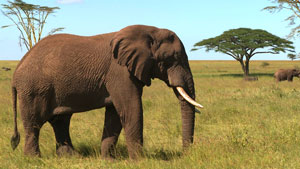|
The World Travel Series is sponsored by Fredonia Place as part of the Lake Shore Savings Season. General admission tickets are available at the door or in advance through the SUNY Fredonia Ticket Office, 716-673-3501. The ticket office is located in the modular complex in the Dods Hall parking lot across from the Williams Center. One child 12 or under is admitted free with each paid adult.
|
Local audiences will soon have the chance to escape the binds of civilization and experience the natural beauty and pure freedom of Africa. This land that belongs to the comedic baboon, fast cheetah, dangerous African Cape Buffalo and majestic lion is the focus of the travel/adventure film “East African Safari,” which will be the opening offering in the 2011-12 World Travel Series at SUNY Fredonia.
.
Filmmaker Rick Ray will personally present the travel-adventure film at 7:30 p.m. on Saturday, Oct. 29 in King Concert Hall at Rockefeller Arts Center. This will be a high-definition, widescreen presentation.
Ray is an award-winning cinematographer, writer, editor and director who has created numerous films highlighting diverse cultures and regions. This includes his 2006 opus, “10 Questions for the Dali Lama,” which earned numerous awards. He most recently visited Rockefeller Arts Center in 2008 with his film “Soul of Morocco.”
With “East African Safari,” Ray explores the safari destinations of Kenya and Tanzania, topping it all off with a trek to visit the mountain gorillas of Rwanda. Included are stops at Nairobi, Masai Mara, Ambocelli, Kilimanjaro, Ngorongoro, Tarangire and the Serengeti Plains.
The film gets “up-close and personal” with the inhabitants of an “eat or be eaten world.”
Ray begins his adventure in Nairobi where he comes across the remote Suswa Caves. The next stop brings astonishment as Ray watches Lake Nakuru turn bright pink with tens of thousands of flamingos.
The film reaches new heights —literally — with a stop at Ambocelli National State Park where the tallest freestanding mountain in the world, Mt. Kilimanjaro, is located. To top this spectacle, Ray goes on a search for the largest living terrestrial on Earth, the African Elephant. Upon finding these gigantic creatures, Ray states “seeing wild elephants coming across the plains of Africa for the first time will surely be one of the biggest thrills of your life.”
From Tarangire Treetops Lodge to Giraffe Manor, the film also highlights the unique housing that is available as part of many safari adventures. The luxury and elegance of the housing almost seems out of place in the middle of the remote environment of Africa.
Moving back to the wildlife, Ray has a stroke of good luck when he encounters the annual wildebeest migration. This 30-mile-long line of wildebeests is a rare sight indeed, leading Ray to call it “the greatest wildlife show on Earth.”
Not only does Ray show the wildlife of East Africa, but he also explores the many unique cultures that call the region home. Each culture has its own deep history that has helped to shape the people’s beliefs and ways of life.
In Rwanda, Ray speaks with a young woman who lived through the genocide, even though her friends and family died around her. Ray also comes to realize that the Rwandans have been able to come to peace with the past and are now a closer community.
As the film looks at the many cultures that exist within East Africa, it becomes evident that the people have a spirit that is as robust as the wildlife that surrounds them.
To conclude his journey, Ray enters the safari one last time to catch a glimpse of the wild gorillas that live on the Virunga Volcanoes. Once again, he is in luck as he encounters a gorilla family taking a break to feast. Ray gets so close to the gorillas that viewers feel as if they are right next to the animals.
As the gorillas walk off into the mist, Ray leaves viewers with this thought, “something came over me that I won’t soon forget, a deep appreciation maybe, for the wonders of our Earth and for the magic and mystery of the safari in East Africa.”




